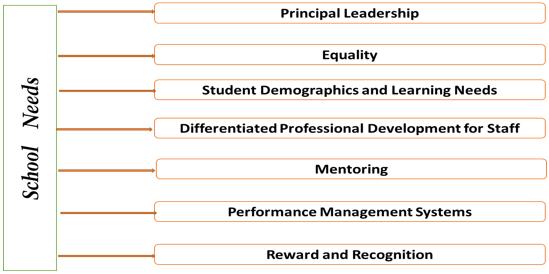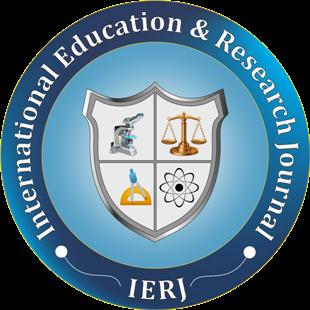ABSTRACT
Human resources are the most important resources of the organization and they must be considered with the highest level of attention and interest. The effective managementofhumanresourceshasbecomedecisiveinthecompetitivenessanddevelopmentofeveryorganization.Inanyorganization,employeesareconsidered anessentialstrategicasset.HumanResourceManagementreferstotheorganizationalfunctionwhichincludespracticesthathelptheorganizationstodealeffectively withitspeopleduringthevariousphasesoftheemploymentcycle.HRMisamanagementfunctionconcernedwithrecruiting,motivating,andmaintainingpeoplein anorganization.Itisthecoreareaofconcernforeveryorganization,whetherconcernedwithpublicaffairsorprivate.
KEYWORDS:Administrators,Organization,Staff,Leadership,Mentoring,Recruitment,Training.
INTRODUCTION:
“Role of HRM & OB in today's educational Institution/university administration”(Dr.M.L.Vasitha,Mr.B.S.Chauhan,2011)Administratorsshouldtherefore deal with staff individually and collectively with a view of understanding them deeply Since there is a lot of noise being made very where to attract and retainthebesttalentfromtheirspecializationsinthesespecialistpoolsofeducational institutions, the issue needs to be addressed proactively to procure, developandutilizethesetalentsuptotheoptimumlevel.
“Humanresourcemanagementineducation:Recruitmentandselectionofteachers”(VickiCameron,PeterGrootenboer,2018)HRMisinitsinfancyinschools, asevidencedbythesmallnumberofHRmanagersidentifiedinthisstudy Potentially, changes to school leadership structures to include HRM expertise could leadtoschoolimprovement.Thereisanopportunityforeducationtodrawonthe currentHRMliteratureandevidence-basedpracticewhichisconstantlyevolving.
ByshowingthatHRMpracticesarepositivelylinkedtoorganizationalsuccess (Arthur, 1994; Huselid, 1995; Delery & Doty, 1996; Guthrie, 2001; Boselie, 2010),strategicHRMcanbedescribedasinvestinginHRMpracticestoimprove financialoutcomes(Boudreau,2003).Inthefieldofeducation,theproductofthe organization is the education, and the future success of children, the future of their communities, and the economic, and social well-being of the country There'sevidencethatshowsthatprincipal'sandteachers'performancehasmore effectonstudentachievementthananyotherfactor,andtheteacher'seffectivenessinincreasingstudent'sperformancevarieswidely Giventhesehighstakes, itisimperativetoactontheknowledgeandstrengthentheeducationworkforce toservestudentsbetter
Ineveryorganization,therearethreemajorresourcestobemanagediftheorganizationwantstoachieveitsobjectivesandgoals.Theseresourcesareman,materials, and money The critical factor out of three is the man. The reason is that every man is born with the unique characteristic way he thinks, feels, reasons, andacts.Moreover,manonlycontrolsandcoordinatestheotherresourcesand theyconstitutethevitalworkforceofanorganizationandarereferredtoaspersonnel.Sincehumannatureplaysanimperativepartintheoverallsuccessofan organization, it is therefore important to have a cordial working relationship betweentheEmployeeandtheEmployerwhichresultsinthesuccessoftheorganization.
HumanResourceManagement,whichinvolvesefficientandeffectivemanagementwithinanorganization,isoneofthevitalfunctionsofEducationalAdministrators.Thisisbecauseeveryadministratorhasafunctiontoperformthrough hisstaffandhisabilities.Everyeducationalinstitutionlikeotherformalorganizations needs human beings to execute its program and achieve educational goalsandobjectives.
Therefore,establishingadedicatedHumanResourcefunctionwithintheschool islikeanyotherformalorganizationisnowbecominganeedofthedayasthis helpstheschooltomeetthepresentaswellasthefuturerequirements.
CONCEPTOFHUMANRESOURCEMANAGEMENT:
Newhypothesesandmethodologicalmodelshavebeencreatedbyresearchersto discuss a wide variety of phenomena relevant to the HRD profession (Torraco
2004). HRM is concerned with the people dimension in management under whichtheconsiderationisgiventowardsrecruitment,developmentofcorecompetencies through motivation, and training, which results in the retention of humanresourcesinanorganization.Hence,itisconsideredastheprimaryfunctionofthemanagement. Ithelpstoensuretherightmanfortherightpositionand attherighttimeinachangingenvironment."Themanagementofmanpower"is an important and challenging job because of the dynamic nature of the people. No, two people aren't similar in mental abilities, tacticians, sentiments, and behaviors; they differ widely as a bunch and are subject to varied influences. Moreover,HRMisconcernedwiththedevelopmentofhumanskill,knowledge, andabilitytoperformorganizationaltaskseffectivelyandefficiently Itisafield ofstudyconsistingoffourfunctions-acquisition,development,motivation,and maintenanceofhumanresources.Theacquisitionisexpoundedongettingpeople, development is to prepare them for work, motivation refers to activating them,andatlast,maintenancereferstokeepthemretainedwithintheorganization.
InIndia,LarsonandTubroLtd.,aprivatesectorcompanyintroducedtheconcept ofHumanresourcesin1975intendingtofacilitatethegrowthofemployees,especiallypeopleatthelowerlevels.Lateron,amongthepublicsectorgovernment companies, it was BHEL that introduced the concept in 1980. According to Megginson (1977), Human Resource refers to "the knowledge, skills, creative abilities,talentsandaptitudesobtainedinthepopulation;whereasfromthepoint of view the individual enterprise, it represents the full of inherent abilities, acquired knowledge and skills as exemplified of the skills and aptitudes of its employees.”HRMisthattheprocessofmanagingpeopleofanorganizationwith ahumaneapproachthroughwhichanorganizationcanutilizetheoptimumlevel ofhumantalentsfortheadvantagesoftheorganization'sgrowth,development, and truly the self-satisfaction of the employees. Thus, HRM is a system that focuses on human resources development on one hand and effective managementofpeopleontheotherhandsothatpeoplecanenjoyhumandignityintheir employment.Therefore,HRM istheartofmanagingandmobilizingpeoplein theorganization.Itisdonethroughtheapplianceofvariouspracticesandpolicieswhichultimatelyvalueshumanresourcesasasignificantassetofanorganization.Itintegratespersonnelfunctionsintostrategicmanagement.Gettingand keeping good people is critical to the success of every organization, whether profitornon-profit,publicorprivate.
ROLEOFHUMANRESOURCEMANAGEMENTINEDUCATION:
Allorganizationsincludingeducationalinstitutionsaremadeupofpeoplewho chosetoworkinitprimarilybecauseitenablesthemtosatisfyaminimumofa numberoftheirneeds.Virtuallyeverybodyworksplaysoriseducatedinanorganization.Organizationalbehaviorfollowstheprincipleofhumanbehavior Organizational behavior is human behavior in an exceedingly particular setting. HRMpurposestousethedifferentorganizationalbehaviortheoriestomaximize theoutputinthefieldofeducationwhichunifiesanorganization'smission,strategy,andvalues.
The best decision-makers set clear priorities with an open mind to hear other team members and willing to change for a better alternative understanding the realisticsituations.
Organizationsrepresentaconstantinteractionbetweenstructureandprocess.To getanassignmentaccomplishedinanorganization,weneedtodefinewhodoes
Research Paper HRM E-ISSN No : 2454-9916 | Volume : 8 | Issue : 5 | May 2022
19 InternationalEducation&ResearchJournal[IERJ]
Copyright©2022,IERJ.Thisopen-accessarticleispublishedunderthetermsoftheCreativeCommonsAttribution-NonCommercial4.0InternationalLicensewhichpermitsShare(copyandredistributethematerialinany mediumorformat)andAdapt(remix,transform,andbuilduponthematerial)undertheAttribution-NonCommercialterms.
what.Therefore,definingtherolesandresponsibilitiesofallstaffbecomesacritical success factor as this helps the individual to grasp understand their roles withinthecontextoftheschool'svision.Thehighercognitiveprocessisprobablytheforemostimportantcomponentineducationalmanagement.Theability tomakedecisionsandstickingtothemresponsiblyisthatthekeytoattainingeducationalgoals.
Therefore,forthestaffwithintheHRdepartmentoftheeducationalinstitutions tofunctionwithpeoplehe/sheisworkingwithandabletointerprettheirbehavior Teachersinschoolshouldnotbelookedatasmereresourcesbutasvaluable humanbeings.Therefore,developinghumanrelationswithintheschoolhelpsit toachieveitsgoalssuccessfully
Goodhumanrelationsinanorganization,forittofunctioneffectivelyandefficientlycannotbeoveremphasized.Itprovidesknowledgeonhowpeopleinteract andrespondindifferentorganizationalsituationstosatisfytheirneedsandinthe process meet organizational goals.Theprincipals' ability to understand his/her teachers and staff and their problems, and his/her belief in, and the practice of democratic leadership will go protracted thanks to making him/her succeed in his/hersupervisoryandadministrativetasks.
Theauthorconcentratedonthemostimportantissueconcerningtheefficientand confidentialusageofcomputersineducation(ManiMookkiahet.al20121).EducationalAdministrationistheintegrationandmobilizationoftheeffortsofindividualsandresourcesfortheachievementofeducationalobjectives.ItisthereforeimperativethatthePrincipalcultivatesthehabitsofHumanRelationsinall hisodiousadministrativetasks.Humanrelationsshouldfocusonteamworkers ashumanbeingsratherthanasproducers.Itimprovesefficiencyandenhances professionalisminteachingandlearningpractices.Alsotoadopteffectiveclassroommanagementforastress-freestudentenvironment.Thisisverytrueinthe contextoftheschoolastheteachersplayacriticalroleinhelpingthechildrento achievetheiroptimalperformance.
The human resource management function has the moral responsibility to develop and implement processes that are teacher-centric.The principal as the school leader should be extensively involved in developing and implementing theseprocesses.

Also,theresearchonstressmanagementshowsthattrainers,educators,andeducationaladministratorsarethesecondlotafterdoctorsandcounselorswhosuffer the highest rate of burnout. They take care of all, and there is no one in the absenceofanEducationalAdministrator(Principal)tomanagetoburnoutthese trainers,teachers,andfacultymembers.
Totheend,theinstitution'sEducationalAdministrator(Principal)isrequiredto meetthefollowingobjectives:
1. Recruitment and selection, developing a strong talent pool within the school.

2. Helpingincreatingaworkingenvironmentthatisconduciveforhis/her membersofstafftopromotemaximumcontentmenttherebymotivating them.Teachers,asanemployeewithinaformalcorporateorganization, liketoworkinanenvironmentthatisbuiltontrust,respectfortheindividual. Encourages research in modern pedagogical practices, teamwork,etc.
3. Ensuringthattheabilitiesandskillsofteachersandstaffareusedtothe optimuminpursuanceoftheinstitution'smissionandmandate.
4. EnsuringeffectivenessinEducationalAdministrationlargelydepends on Team Leader's commitment to the mission and priorities strategicallyplacedfortimelyimplementationbyallthestakeholders.
5. Therefore,theprimaryresponsibilityofahumanresourcemanagement functionistoensurethathumanresourcesareutilizedandmanagedas efficientlyandeffectivelyaspossible.
Humanresourcefunctionscangenerallybeclassifiedintothreebasicfunctionsnamely:
1. Optimum utilization of teachers and staff to meet educational institutes needs
2. Themotivationofemployeestomeettheirneedsandorganizationalneedsin unison.
3. Create and provide a conducive and stress-free teaching-learning environmenttoachievedesiredanddecidedhigheducationalstandard.
theEducationalAdministratorneedstoprovidemanagementoversightandguidancetotheHumanResourceManagementfunctionandtomeettheneedsofthe changinglandscape.
Fewofthevaryingneedsoftheschoolsincludethefollowing:
1. Hiringandretainingqualifiedteachersandstaff.
2. Developingleadershipabilitieswithintheschool.
3. ImplementingInclusiveEducation.
4. Developingandimplementingdifferentiatedprofessionaldevelopment programs for teachers will help them to reach their potential. In turn, thishelpsthestudentstoachievetheirpotential.Teacherperformanceis closelyrelatedtostudentperformance.
5. Implementingarobustandtransparentperformancemanagementsystem.
6. Implementingperformancerewardsandrecognition
7. Incorporatingtechnologyineducation.
8. Talentretention.
Figure1.
SchoolsNeeds
The human resource management function needs to clearly understand these changingrequirementstoimplementpoliciesandpracticesaccordingly Thesuccessoftheschoolortheeducationalinstitutewillbeincreasinglydependenton the leadership of human resource management. The human resource managementfunctionshoulddeveloprobustprocessesfortalentacquisition,retention.
Thefollowingillustrationprovidesanexampleofsuchaprocess.
Figure2.HumanResourceManagementFunctionNeeds
RecruitmentandSelection:
ChangingNeedsofSchoolsandHowHumanResource
ManagementHelps toMeetThem:
Tremendous changes are happening within the environment where the schools operate.Withtheonsetofglobalizationandtechnology,thedynamicswithinthe schoolanditsexpectationsarerapidlychanging.Therefore,itisimperativethat
Thisinvolvessearchingforasuitablepersontofillthevacantornewposition. Thebasicgoalofrecruitmentistolocateaqualifiedteacherwhowillstaywith theschooltohelpstudentstoreachtheirpotential.Giventhecurrentchallengeof hiringqualifiedteachers,whichislikelytogrowinthefutureaswell,itisimportanttodevelopdiversechannelsfortalentacquisition.Innovativepracticesmust bedevelopedandimplementedtomeetthisgrowingrequirement.
Induction:
Teachersandstaffwhoareselectedshouldundergoastructuredorientationprogramtounderstandthevisionoftheschoolanditseducationalobjectives.This
Research Paper E-ISSN No : 2454-9916 | Volume : 8 | Issue : 5 | May 2022
20 InternationalEducation&ResearchJournal[IERJ]
will help the new teachers, lateral as well as freshers, to align to the organizationalvision.Theclarityintheirrolesandresponsibilitieswillhelpthemtobuild afoundationforhighperformance.
TrainingandDevelopment:
Thisisanimportantfocusareafortheschoolasithelpsintalentretentionaswell asthedevelopmentofaconductiveenvironmentwithintheschool.Policies,procedures,andmechanismsshouldbecreativelydesignedanddevelopedthatfostergrowth.
Examplesinclude:
a. Differentiatedprofessionaldevelopmentforteachers.
b. SalaryAdministration.Thisreferstothefinancialbenefitsthataregivento teachersandstaffforthejobstheyhaveperformed.
c. Performance management system. This is the continuous process of feedbacktoteachersandstaffabouthowwelltheyhaveperformedontheirjobs.
d. MaintainingregularlycordialrelationswithallteachingandNon-teaching staff in a non-teaching manner and ensuring job security through several staffwelfaremeasureswillproducelastingjobperformance.
CONCLUSION:
According to C & Kalaiyarasan, (2018) improves and assists in the growth of municipal capacity in the fields of planning, resource sharing, and human resource management. To meet the rapidly changing needs, educational institutes should strongly consider establishing a dedicated Human Resource Managementfunctionandinvestinitsleadership.Asstudentoutcomesareafunction oftheteacher'sperformance,itisimportanttodesignandimplementcreativeas well as innovative practices that encourage talent acquisition, retention, and growth.Iftheseneedsareneglected,itwouldleadtofailureinachievinggoals fortheadministrationofthefutureeducationsystem.
Tothisend,ithasthereforebecomenecessaryforinstitutionstoadvocatetheuse of good human relations so, as to ensure effective and efficient administration. School leadership should need to motivate teachers and staff not only through monetarymeansbutalsorecognizetheindividual'sworthbyprovidingrewards acknowledginginpublicfunctionsinthepresenceoftheirfamilymembers,Parentsandstudents,andschoolstaff.
ConflictofInterest:
Theauthorsdeclarethattheyhavenoconflictofinterest.
Acknowledgements:
IwouldliketothankmySupervisorandHODDr G.KalaiyarasanforhisdirectionsaswellasacknowledgingthesupportofDr R.Ramnath,Dr N.Sasikumar, for encouraging developing the content of this paper SpecialThanks to Mani Mookkiahfortheirunexpectedhelpandsupport.
REFERENCES:
I. Dr M.L.Vasitha,Mr B.S.Chauhan,(2011,Feb)“RoleofHRM&OBintoday’s educational Institution/university administration” International Journal of ManagementandAppliedScience,Volume-4,Issue-2,pp.89-94
II. VickiCameron,PeterGrootenboer,(2018,Dec).“HumanResourceManagement inEducation:RecruitmentandSelectionofTeachers”,BritishJournalofEducation,Vol.2,No.7,pp.26-31.
III. Delaney.,T.,J.andHuselid,M.,A.(1996).“TheImpactofHumanResourceManagementPracticesonPerceptionsofOrganizationalPerformance”, Academyof Managementjournal,39(4),pp.949-969.
IV Andrews,C.,&Boddington,R.(2010).“TheDevelopmentofNationalAdvisory Standards for the Professional Practice of HR in Australian Universities” http://works.bepress.com/chris_andrews/2
V Ackom,A.B. (2011). “Human Resource Management Practice at University of Nebraska” http://wwwirex org/ sites/ default/ files/ Ackom% 20Case% 20Study.pdf
VI. Mookkiah,M.,&Prabu,M.M.(2020).ImpactofSocialMediaontheAcademic AchievementofSecondarySchoolStudents.JournalofXi'anUniversityofArchitecture & Technology, 12(3), 3106-3109.https://www.xajzkjdx.cn/gallery/270mar2020.pdf
VII. Bush, T (2003). “Theories of Educational Leadership and Management”, Sage Publications.
VIII. CIPD&UPA.(2008).“LeadingHRforHighPerformanceinHigherEducation”. http://wwwcipd co uk/NR/rdonlyres/4AD775C13621-4D8B-9262-0DE659 C9395D/0/leading_hr_performance_higher_education.pdf
IX. Padhy S. N., Dash S.K. and Mohapatra, R. (2001). “Human Environment, as introspected by the Sages and Seers in Vedic Age: A Contemplative Scientific Review”,ManusmrutiHumanEcology (10),177-200.
X. Mani,M.(2019).AStudyOnSelfEfficacyOfHigherSecondaryStudentsWith RespectToLocalityOfTheSchools.ThinkIndiaJournal,22(10),807-813.
XI. JudyWurtzel,RachelCurtis,(2008,July).“HumanCapitalFrameworkforK-12 UrbanEducationOrganizingforSuccess”,TheAspenInstitute.
XII. Michael Hansen. (2013, Feb).“Investigating the Role of Human Resources in
School Turnaround, A Decomposition of Improving Schools in Two States”. AmericanInstitutesforResearch.
XIII. SumathiReddy“BestpracticesinHumanResourceManagement”
XIV Supriya, P Inamdar, Dr ShinuAbhi. (2020, Feb.).“A Strategic approach to HR Analtics:Aframeworkforemployeecycle”, TheJournalofAllIndiaManagementAssociation.
XV Kalra, S. K. (1997). Human Potential Management: Time to Move Beyond the Concept of Human Resource Management?. Journal of European Industrial Training.
XVI. C, B. J., & Kalaiyarasan, G. (2018). The Development of New and Innovative Human Resource Managerial Practices of Teachers Model (HRMPModel) –A ConceptualFramework.JournalofAppliedResearchandSocialSciences,5(16), 12-19.
XVII. Arthur,J.B.(1994).EffectsofHumanResourceSystemsonManufacturingPerformanceandTurnover AcademyofManagementJournal,37(3),670-687.
XVIII. Delery, J. E. & Doty, D. H. (1996). Modes of Theorizing in Strategic Human Resource Management: Tests of Universalistic, Contingency, and Configurational Performance Predictions. Academy of Management Journal, 39(4), 802835.http://dx.doi.org/10.2307/256713
XIX. Mookkiah,M.,Mahendraprabu,Kalaiyarasan,Ramnath,Sasikumar,Kumar,S., & Sathyaraj. (2021). Yoga Based Intervention Strategies in Accelerating Self-efficacy Among Primary School Teacher Elementary Education Online, 20(4),794–805.https://doi.org/10.17051/ilkonline.2021.04.85
XX. Huselid,M.A.(1995).Theimpactofhumanresourcemanagementpracticeson turnover, productivity, and corporate financial performance. Academy of managementjournal,38(3),635-672.
XXI. Rosidi,I.(2020).ConsumingRepresentationsofKoreanTVDramasamongIndonesianMuslimYouth.JurnalTheMessenger,12(2),111-121.
XXII. Natarina, R. E., & Bangun, C. R. A. (2019).The Use of Affiliate Marketing in ImprovingPegipegiSales.JurnalTheMessenger,11(2),157-167.
XXIII. Guthrie,J.P (2001).High-involvementworkpractices,turnover,andproductivity:EvidencefromNewZealand.AcademyofmanagementJournal,44(1),180190.
XXIV Boselie, P (2010). High performance work practices in the health care sector: a Dutchcasestudy InternationalJournalofManpower
XXV Mani,M.,&Prabu,M.M.(2019).TeachersSelf-efficacyScale:Developmentand Validation.ReviewofResearch,8(6),1-8.
XXVI. Torraco, R. J. (2004). Challenges and choices for theoretical research in human resource development. Human Resource Development Quarterly, 15(2), 171188.
XXVII. Marta,R.F.,&Fernando,J.(2020).DialecticsofforgivenessbetweenethniccommunitiesforwestKalimantanharmony JurnalTheMessenger,12(1),1-13.
XXVIII. Mahalakshmi,N.,Mahendraprabu,M.,Mookkiah,M.,&Kumar,S.(2020).Work ValuesofSecondaryGradeTeachersbasedoncertainselectedvariables.Journal ofXi'anUniversityofArchitecture&Technology,12(3),4910-4918.
21 InternationalEducation&ResearchJournal[IERJ] Research Paper E-ISSN No : 2454-9916 | Volume : 8 | Issue : 5 | May 2022



